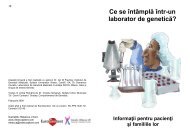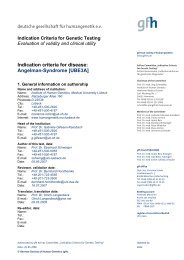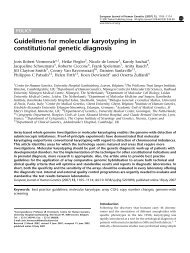Cytogenetic Guidelines and Quality Assurance - EuroGentest
Cytogenetic Guidelines and Quality Assurance - EuroGentest
Cytogenetic Guidelines and Quality Assurance - EuroGentest
You also want an ePaper? Increase the reach of your titles
YUMPU automatically turns print PDFs into web optimized ePapers that Google loves.
Ataxia telangiectasia <strong>and</strong> Nijmegen syndrome<br />
The aberration frequency in irradiated cultures, scored<br />
from 50 to 100 metaphases, should be compared with<br />
normal control cultures. As some ataxia telangiectasia<br />
patients display an intermediate response to irradiation,<br />
screening of 50 b<strong>and</strong>ed metaphases for rearrangements,<br />
involving the T-cell antigen receptor loci<br />
on chromosomes 7 <strong>and</strong> 14, should also be carried out.<br />
5.2.5 OTHER RARE SYNDROMES DETECTED<br />
BY CYTOGENETIC ANALYSIS<br />
Despite recent advances in the underst<strong>and</strong>ing of the<br />
molecular basis of some disorders, cytogenetic studies<br />
are often the first step in making a diagnosis.<br />
Sufficient numbers of metaphases must be examined<br />
in order to ensure that any chromosomal damage<br />
detected is significant.<br />
Roberts syndrome<br />
Fifty block (Leishman/Giemsa stained) or C-b<strong>and</strong>ed<br />
metaphases should be scored for paired centromeres,<br />
centromeres puffing <strong>and</strong> tramline chromosomes. Fifty<br />
b<strong>and</strong>ed metaphases should be counted, for evidence of<br />
aneuploidy.<br />
ICF syndrome<br />
Fifty b<strong>and</strong>ed metaphases should be scored for anomalies<br />
of the heterochromatic regions of chromosomes<br />
1, 9 <strong>and</strong> 16 <strong>and</strong> for multi-branched configurations.<br />
5.3 ONCOLOGY: LEUKAEMIAS AND SOLID<br />
TUMOURS<br />
All laboratories offering a diagnostic service should be<br />
able to provide an analytical <strong>and</strong> interpretive service<br />
for a range of haematological disorders see Appendix<br />
1. Referral can be at diagnosis, follow up after treatment,<br />
including transplantation, relapse/transformation<br />
or as part of a national or locally agreed trial.<br />
5.3.1 BONE MARROW<br />
In haematological <strong>and</strong> solid tumour cultures, the<br />
culture conditions should be optimised where possible<br />
by utilising direct, short term <strong>and</strong> synchronised<br />
cultures to improve the mitotic index. Laboratories<br />
should be aware that culture times may affect the<br />
detection of an abnormal clone. When B- or T-cell<br />
lymphoproliferative disorders are suspected, suitable<br />
mitogens should be added to additional cultures.<br />
5.3.2 SOLID TUMOUR<br />
Solid tumour cultures may require both multiple<br />
cultures <strong>and</strong> longer incubation (>72hours). It is<br />
recommended that the laboratory has previous<br />
experience in the tissue culture of various cell types<br />
before setting this up as a diagnostic service.<br />
5.3.3 HAEMATOLOGICAL CHROMOSOME<br />
ANALYSIS<br />
Sufficient number of cells should be examined to<br />
detect the presence of clonal evolution. The quality of<br />
metaphases obtained from unstimulated blood <strong>and</strong><br />
from bone marrow samples is generally poor,<br />
particularly in leukaemia. As normal cells with better<br />
chromosome morphology may be present, it is<br />
important to analyse cells of varying quality in order<br />
to maximise the likelihood of detecting a clone.<br />
Abnormal cells are often those of poorer quality <strong>and</strong><br />
21<br />
sufficient cells should be analysed to establish the<br />
clonality of the abnormality (see ISCN for definition<br />
of clonality).<br />
There is a high possibility of an abnormality being<br />
present in either a few cells or the presence of several<br />
subclones. When a normal karyotype is found, it is<br />
preferable that a minimum of 10 cells are fully<br />
analysed <strong>and</strong> a further 10 are screened for abnormal<br />
chromosomes for diagnostic samples, referral at<br />
relapse or transformation. If a sample yields fewer<br />
than twenty normal cells, the report should be suitably<br />
qualified.<br />
For referrals where cytogenetic follow-up after<br />
treatment/remission is required the following analysis<br />
is recommended:<br />
If a normal result was obtained at diagnosis,<br />
further analysis is usually not appropriate.<br />
If abnormal result was obtained at diagnosis: a<br />
minimum of 20 metaphases should be scored<br />
for the relevant anomaly. In some instances,<br />
FISH may be appropriate for follow-up studies.<br />
For post-transplantation samples, a minimum of<br />
30 metaphases should be scored for the presence<br />
or absence of the marker used to differentiate<br />
between donor <strong>and</strong> recipient cells e.g. the<br />
Y chromosome in mixed sex transplants. FISH<br />
may be more appropriate here also.<br />
N.B. Definition of Scoring - To check for the presence<br />
or absence of a particular karyotypic feature in a<br />
number of cells<br />
5.3.4 ONCOLOGY CHROMOSOME ANALYSIS<br />
Adequate numbers of metaphases of varying quality<br />
should be analysed or examined before the report of a<br />
normal karyotype or of the existence of an abnormal<br />
clone is given. If a sample yields fewer than ten<br />
normal cells, the report should be suitably qualified.<br />
Reporting <strong>and</strong> interpreting the results of tumour work<br />
is a specialised area, where close co-operation between<br />
the laboratory <strong>and</strong> the referring histopathologist<br />
is vital.<br />
5.4 CGH AND MICROARRAY TECHNOLOGY<br />
These methods are still considered to be experimental.<br />
However, any laboratory using these techniques in<br />
their clinical work should introduce SOPs. Clinical<br />
samples analysed according to these techniques should<br />
be treated as routine samples once an internal<br />
validation of the test has been established <strong>and</strong> h<strong>and</strong>led<br />
according to appropriate laboratory guidelines.<br />
6. FLUORESCENCE IN-SITU<br />
HYBRIDISATION (FISH)<br />
6.1 GENERAL<br />
Interphase <strong>and</strong> metaphase FISH, either as a single<br />
probe analysis, or using multiple chromosome probes,<br />
can give reliable results in different clinical situations.<br />
It should be noted that there may be variation in probe<br />
signals both between slides (depending on age,<br />
quality, etc. of metaphase spreads) <strong>and</strong> within a slide.<br />
Where a deletion or a rearrangement is suspected, the<br />
signal on the normal chromosome is the best control















